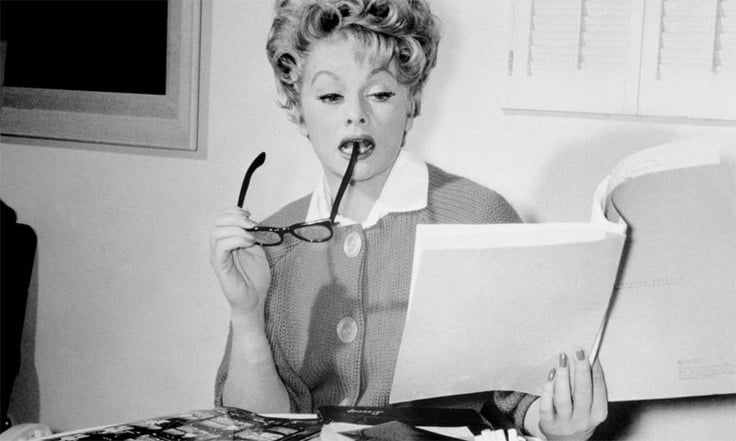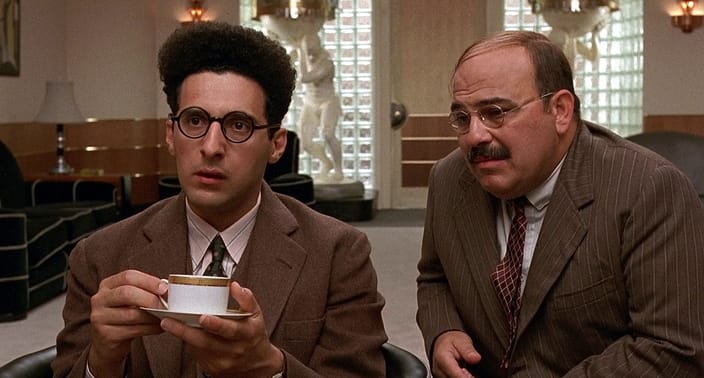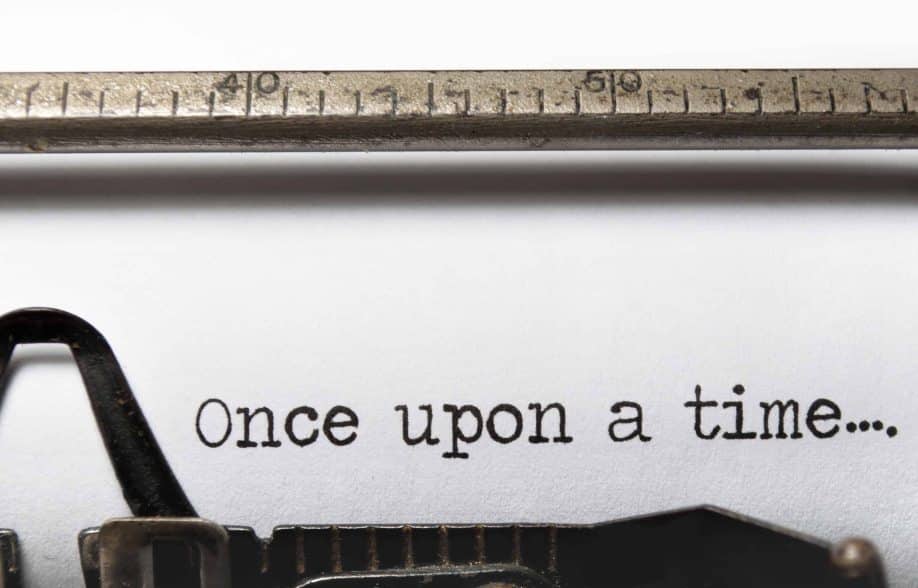What will make your one-page pitch standout from the gazillion other pitches out there? And how do you blend a screenwriter’s creative talents into a technically sound pitch, especially when most don’t have a business background or negotiation experience?
In this article, we’ll take a look at how to build an effective and powerful one-page pitch for your story. Let’s dive in.
Table of Contents
- What is a One-Page Pitch?
- 14 Essential Elements of a One-Page Pitch
- 1. Audience
- 2. Genre
- 3. Antecedents
- 4. The “What If”
- 5. The Logline
- 6. Protagonist/Hero
- 7. Call to Adventure
- 8. Desire
- 9. Conflict
- 10. Action
- 11. The Major Setback
- 12. The Climax
- 13. Deeper Meaning
- 14. The Awkward Segue: Give Your Reader Room
- Putting Your One-Page Pitch Together
- In Conclusion
What is a One-Page Pitch?
The one-page pitch is a concise proposal that conveys the essential elements of your screenplay and idea.
- This pitch is typically delivered to a potential producer or representative.
- You might have already written the script and the pitch is just to get someone to read it.
- Or your one-page pitch might be intended for someone to buy into the idea and pursue it as a potential commission, for example.
Either way, it’s in that one page where you must convey the essential elements of your story and build a connection with the audience you’re sending your pitch to.
You shouldn’t be thinking about a potential $50,000 contract payment right out of the gate. You shouldn’t be thinking about how to negotiate your right to act in the film when it’s produced. And you shouldn’t be haggling over the smaller details of a potential production.
You just want to get the listener to buy into your idea. Everything else is decided later.
You must elicit the emotional potential your screenplay promises by conveying its key story elements. That, in turn, will increase the chances of your audience wanting to read your script.

Misconceptions and Mistakes of a One-Page Pitch
The problem is, we can get so caught up in all the details of our story that we lose sight of what our key story elements are. Consequently, we lose the attention of the potential buyers or representatives we’re pitching to. This is typically due to a one-page pitch being…
- Too generic (simple title, logline, summary)
- Ignoring the audience (agent, director, or producer)
- Too lengthy
- Consisting of unnecessary details
- Ignoring essential story elements
- Lacking a clear arc
The pitch template we design below will guide you step-by-step to overcome all these common traps. It will also empower you to turn your one-page pitch into a well-spoken presentation.
A key mistake writers can make is thinking of the agent/producer they’re pitching to as a gatekeeper. While the person you’re pitching to holds the power of whether or not to read your screenplay, having an oppositional mindset can add further anxiety and negative energy to your pitch.
- Rather, in this approach of the one-page pitch, we’ll be considering your audience more as a potential ally than a gatekeeper.
- Consider the fact you’re not just pitching your story here. You’re pitching yourself and your writing style and the potential to be a phenomenal collaborator.
If your visions align, then you have the potential for a long-lasting relationship. If not, that’s okay. So long as you delivered the most effective pitch, a rejection is fine because your visions simply did not align. The key thing is having an effective pitch, concise and clear for the audience to understand in no uncertain terms.
14 Essential Elements of a One-Page Pitch
Consider the elements listed below as key ingredients for an effective one-page pitch.
Not only will each ingredient bolster your pitch, but it’ll succinctly clarify the scope of your story, and be malleable enough to present your story as a verbal presentation as well.
1. Audience

Knowing the audience you’re pitching to is your first step to breaking the common mold of a typical one-page pitch. It’ll help you personalize your approach and build a better connection with your potential reader or buyer.
Consider for a moment the categories of people who you could be pitching to: agents/managers, directors, and producers. Each person also has a different goal in mind.
- If it’s an agent, they’re looking for a writer who promises long-term writing and a collaborator.
- Who are clients that you personally enjoy the work of? Do you have accolades/awards that showcase you’re a committed writer?
- A producer is looking for a script that promises artistic/commercial appeal, but not at a massive risk (especially if you’re a new writer).
- Does the production company you’re pitching to produce $100 million+ budgeted films? Or are we pitching to an independent film company?
- Directors/actors are always looking for characters and stories that are exciting and will allow them to exhibit their talents.
- So if you’re lucky and have a director who could possibly direct your film, consider if they’re interested in filming a full feature, a short, or a series.
- Consider a director’s budget on previous films, and the genre/tone they typically work in.
Knowing your audience also enables you to slip in a 1-2 sentence compliment conveying your knowledge of your audience’s previous films, creating a space that’s friendly, yet personal.
Doing research on your audience before sending your one-page pitch also prevents wasting time with generic mass email send-offs. Rather, your focus becomes geared towards targeting agents and producers who will actually be interested in your idea.
2. Genre
Genre is the key ingredient for establishing an image of the story you want to tell in your audience’s mind. How will this story look, feel, and place within the marketplace?
For example, say you’ve written a story about a space hero saving the world from impending threat, that story’s going to look different if it’s a comedy (ie. PIXELS), horror (ie LIFE), sci-fi/adventure (ie GUARDIANS OF THE GALAXY), or odyssey/drama (ie INTERSTELLAR).
So know your film’s genre. Not just to drop it in as a description for a subheading. But more importantly, to build further connection with the audience you’re pitching to and set the ground for our next ingredient: antecedents.

3. Antecedents
Antecedents, for our purposes, are films and television examples that are similar in genre and tone of your film. So again, if you’ve written a dramatic space odyssey, INTERSTELLAR might be a film that fits as an antecedent. Fairy-tale action-adventure film? Then maybe MALEFICENT could be an antecedent.
When coming up with an antecedent for your pitch, try and look for films in your genre that have been critically or commercially successful before. After all, you don’t want to get your audience thinking of a dud.
Slipping 1-2 antecedents into your one-pager bolsters your pitch in a few ways…
- Hints to the potential commercial success of your film.
- Connecting your film to previously successful examples in your genre helps to curb worry over potential marketability, giving a clear reference point for the marketplace journey.
- Subtly introduces the genre of your film with familiar stories.
- This makes it clear to your audience the type of story you’re telling while minimizing confusion.
- Avoids false promises.
- Common mistakes writers make are false promises that their screenplay will garner loads of money at the box office. But writers aren’t in a position to make those claims and it can come off as arrogant as well as phony.
- Hinting at an antecedent helps overcome that trap, while still hinting at commercial success. You’re giving your audience a believeable framework to work from.
Antecedents help show there is a path for your idea, a reference point to bounce off creatively but probably most importantly, commercially.
That said, how will your story stand out and differ from those previous films? That’s when the next ingredient comes in.

4. The “What If”
So now you’ve armed yourself with the specific genre of your film, antecedents in a similar genre, the tone of your script, and knowledge of your audience.
But what about the artistic appeal? How is your screenplay original and different from all the rest in that genre?
Using the words “what if” provides that segue way from here are antecedents that promise my screenplay’s commercial success… to…. here’s how it’s also new and fresh.
As Christopher Nolan states-
“…you have to be very aware that the audience is extremely ruthless in its demand for newness, novelty and freshness.”
Using a “what if” can help highlight how your idea is different and therefore worthy of pursuit. You’re serving the audience with familiar reference points before flipping the script with a new take. We can concise what your story’s about even further, with the next key ingredient to your pitch:
5. The Logline
Before we jump into the key character elements of your screenplay, let’s further concise your story from just one page into one sentence. A logline serves as a quick 1-line summary of your screenplay.
Loglines simply follow this structure.
- Your protagonist, who takes an action to accomplish a desire while facing a terrible conflict.
Check out our article on logline examples to see what fantastic loglines look like.
Having your logline ready at the outset of your pitch or at the end is a helpful way to further convey the essence of your film in the mind of the reader. It will also serve as a nice, brief recap for your one-page pitch once you’ve conveyed the essential story elements.
Nailing your logline should probably take time. It’s not a couple of lines dashed out to hint at the story. It is the story. And if a good logline comes easy to you, that’s probably a sign that you’re onto a killer idea. Your logline is the key to understanding your story, both from your perspective and the audience’s perspective.
6. Protagonist/Hero

You can’t get too far in your pitch without introducing your hero. The key here is to not get lost in unnecessary details such as their clothing style, history, personal preferences, etc…
Rather, focus on introducing the key defining features of your hero as it relates to the story.
- Role/title: What is their position in life when we meet them? Are they a retired underground assassin (JOHN WICK), an advertising clown (JOKER), or a computer programmer (EX MACHINA)?
- Empathy: What will connect your audience with your hero?
- Do they suffer from a traumatized past? Does your hero have a special talent like being a chess wiz such as Beth Hermon in THE QUEEN’S GAMBIT? Is he the troubled son of a wealthy business owner seeking to take control of the entire company such as Kendall in SUCCESSION? Or is his dog killed by a group of underground assassins (JOHN WICK)?
- Find 1-2 empathetic traits of your protagonist and convey them in your pitch.
This helps to avoid the common pitfall of getting lost in the jungle of details surrounding your protagonist.
From here, you can explore the details. The reader doesn’t have to go digging in the middle of your proposal for all the key elements because you’ve introduced them already at the outset of your one-page pitch.
So long as you extrapolate on vital details such as your character’s role or empathetic traits, your pitch will hit the vital beats agents and producers look for when deciding to take an idea further. The biggest question – that should have a clear answer in the pitch up front – is why this character?
7. Call to Adventure

So you got the opening, and you’ve given a sense of your protagonist‘s role and key empathy elements that will connect the audience with your character.
What’s next is what Joseph Campbell terms in literature, the “call to adventure”. In other words, what opportunity arises that plucks your hero from their day-to-day life to set off on a journey?
- In SUCCESSION’s first episode, Kendall learns his father will be re-joining Waystar and now must gain his approval for succession of his company.
- In JOKER, Arthur is given a gun to protect himself for the next clown gig he has to do.
- In WHIPLASH, Andrew Neiman is enrolled in a prestigious band at his conservatory school.
Find what plucks your hero from his or her original way of life to the new-found journey. What changes in their ordinary life that brings them to the journey that the story will tell? If outlining your protagonist leads to the question of why this character then the call to adventure should lead to why now?
8. Desire
Once your hero has set out on their journey, they have a desire to achieve. This is where writers can easily fall down at the start of their pitch. It can be easy to get lost in all the detail at the beginning of their script, causing the reader to consequently lose track of the direction of the story.
Your character’s desire/goal line is the vehicle of how the journey of your screenplay will unfold. And for your audience who hasn’t read your script yet, conveying the protagonist‘s desire and goal is vital.
Every story has a clear goal where the hero wants to achieve, prevent, attain, or escape. Essentially, what is this story about on a very fundamental level? What does the character want, what is stopping them from getting it and how will they attempt to fulfill this want? This is what the framework of the story will be. So you must make the want part of it clear to your audience in the one-page pitch.
So include your character’s desire immediately following their introduction. Once again, from there, you can extrapolate on the details of your hero’s outer and inner goals without getting lost in the weeds of your story. Think of the character’s desire as a compass, guiding them and the audience through the story.

9. Conflict
Now we get to the conflict of your story. What is preventing your hero from achieving their obstacle? The greater the obstacle the better. It’ll make the audience you’re pitching to wonder how is it possible your hero will ever achieve their desire. That’s where the emotional impact of your story exists.
- In THE DARK KNIGHT, Batman faces the Joker and utter chaos possibly destroying Gotham and his chance to be with Rachel.
- In WHIPLASH, Andrew’s path to success is stifled by the vicious director himself, who abuses him physically and mentally.
- In WRECK-IT RALPH, the villain is King Candy who controls the races of the kingdom, and thus, whether Ralph wins a medal or not.
Allowing your audience to wonder how your hero will overcome conflict is where the emotional juice is. It is an essential ingredient to entice the audience to want to read your screenplay/idea in order to find out. How much potential will there be for drama, action, or comedy in the obstacles your protagonist will face?
Once you’ve established the desire line in your pitch, stay on course by introducing and describing the conflict your protagonist faces. Then, you can get a little more into what that conflict might actually look like and how it may manifest…
10. Action
‘Action’ means what measures the hero will take to overcome their conflict and achieve the desire throughout Act 2. The course of action you outline will additionally cement in your reader’s mind the type of story you’re telling.
- In THE BATMAN, for instance, Bruce’s goal is to capture the Riddler and prevent Gotham from plunging into chaos.
- Action: To do that, he must solve a maze of riddles to identify who the Riddler is and the corruption plaguing the city.
There are a tonne of previous Batman films, so saying simply Batman wants to save Gotham isn’t a good enough answer. In the case of this story, he must overcome Riddler’s maze of riddles to capture him. This highlights the film’s tone, which is more like a dark thriller than a traditional superhero film.
- In THE MARTIAN, Mark Watney’s goal is to survive as an astronaut while the conflict he faces is being stranded on Planet Mars.
- Action: Survive by planting his own farm and cultivating the land to survive on his grown food long enough until his space team can come back and retrieve him.
- This indicates the nature of the story, one which is intimately focused on the main character and his exploits on Mars.
- In GAME OF THRONES SEASON ONE, the Starks, led by Ned Stark, want to prevent the Lannisters from unjustly ruling Westeros.
- Action: Ned Stark searches for buried secrets in King’s Landing that could potentially exploit the Lannisters and ruin their claim to the throne (this is the main storyline of season one which, spoiler, culminates in Ned Stark’s death.
- This shows that if you’re making a story about multiple dual characters or have additional protagonists, just be sure to highlight their actions/goals as well.

11. The Major Setback
We’ve reached the point in the hero’s journey where your protagonist faces their greatest setback. Joseph Campbell terms this stage in your screenplay as “The Ordeal”. It is a moment in the story where your hero has suffered their greatest defeat.
- In THE DARK KNIGHT, the greatest setback takes place when the Joker blows up Rachel, killing Bruce Wayne’s desire to ever be with her.
- In THE BANSHEES OF INISHERIN, it’s when Padraic’s dog dies after eating one of Colm’s fingers, tainting his desire to rekindle his friendship
- In JOKER, Arthur Fleck discovers his one remaining support, his mother, had neglected his abuse as a child and that he was adopted.
The setback (or ordeal) is the straw that breaks the camel’s back in your story. It’s the moment when all hope is lost. And as mentioned before, the greatest form of emotion comes from the highest level of conflict.
This moment in your one-page pitch will illustrate the heights your story will be able to achieve. How will the story make the audience emote? This is where the major setback can be vital.
12. The Climax
The climax is the final battle of your story. This is the final course of action your protagonist takes to achieve their desire, putting everything on the line.
John Truby writes, “This is the point that determines who, if anyone, wins the goal”.
Sometimes, the climax isn’t exactly a physical battle.
- It could be the final dance between two characters looking to prove something to themselves and their family. This was true, for instance, in SILVER LININGS PLAYBOOK.
- In THE KING’S SPEECH, the climax is when King George VI strives to deliver his wartime speech as clearly as possible.
Usually, the final battle comes down to a choice: a moral choice.
It’s at this point a moral decision is made. Truby writes…
“The moral decision is the moment when he chooses between two courses of action, each of which stands for a set of values and a way of living that affects others.”
For example–
- In THE DARK KNIGHT, Batman must decide between preserving the life of Harvey Dent or killing him to save Gordon’s kid.
- In GAME OF THRONES’ final season, John Snow must decide to either be with Daenerys or end her potential reign of terror.
- In JOKER, Arthur must decide between committing suicide on live television or killing the host he once admired.
NOTE: You don’t have to spoil the ending of the hero. Leave the final choice and the final battle as the end point of your story’s pitch. You’ve established that the final point of the character arc exists. Now it’s up to your audience to decide whether to read on to find out the ending.

13. Deeper Meaning
At this point, we’ve covered the full scope of your story’s character arc. But what’s the deeper meaning or message? What at its essence is your story really about? How is this relevant to the world outside of the story?
For example, it could be said that…
- BATMAN BEGINS is a story about overcoming fear.
- SNOW WHITE AND THE HUNTSMAN is a story about a young woman’s self-empowerment.
Notice that these deeper meanings aren’t specific to one story. They are universal meanings that connect to the human condition.
Use the deeper meaning to connect to the human condition and cap the essence of your story. What will make audiences relate to this story on a human level? How will you capture the attention of those outside the core demographic? Connecting your story to a wider, deeper meaning will help give it a distinctive edge that goes beyond its core elements.
14. The Awkward Segue: Give Your Reader Room
This is it. The end of your one-page pitch. How do you end it though? Often, writers make the mistake of awkwardly ending with writing “Well, that’s my pitch,” or “hope you like it,” or some other “filler” in hopes of ending on a smooth note.
The predicament is you don’t want to end on an abrupt, awkward, or non-smooth note. What if your audience has questions they want to ask still? More often than not, the potential reader you’re pitching to will have questions about your story before wanting to read it.
So end by giving your reader a choice. End on a question or something that will start a conversation. Make a statement that doesn’t necessarily have any room for pushback but instead starts a fire in the reader’s mind.
This helps to overcome any awkwardness at the end of your pitch. It also gives your audience a choice of what to do. Additionally, it conveys professionalism on your end by not assuming your reader will jump to read, but rather, ask questions and engage in a conversation.
Use the choice as a smooth way to end, giving your reader a kind and gentle segue into potentially responding back to your pitch.

Putting Your One-Page Pitch Together
Now you have all the ingredients of your pitch. Furthermore, you have a concise understanding of your screenplay that you’ll be able to convey in person to an agent, manager, or producer.
So how do we piece all these elements together for a succinct, personalized pitch that’s natural and easy to read?
Use the following template below as a guide, and notice how every element listed above is included.
One-Page Pitch Template
Growing up, I always loved (GENRE TYPE) films such as (ANTECEDENT EXAMPLE) and (ANTECEDENT EXAMPLE). So I thought what if there was a film (WHAT MAKES YOUR FILM STAND OUT)…
And that’s when I came up with (TITLE OF YOUR SCREENPLAY) which is about (PROTAGONIST) who is a (ROLE) but who suffers from (EMPATHY-TRAIT…which could also be a special talent, skill, power, or any other trait besides a “suffering”). Except when (PROTAGONIST) comes across (OPPORTUNITY/CALL-TO ADVENTURE), they realize that all they ever wanted was (INNER/OUTER DESIRE)…
So my protagonist sets off for their (DESIRE) by (include ACTION ) to achieve it, except they are faced with (CONFLICT)…. which they try to overcome by (ACTION) until they lose all hope with (MAJOR SETBACK)….And now the hero must take one last stand by (DESCRIBE THE FINAL BATTLE/THE CHOICE your hero must make, without spoiling the ending).
And so while this is a film about (full or partial LOGLINE), it’s really a story about (DEEPER MEANING/THEME of your story). What happens when (FILL-IN-THE BLANK) meets (FILL-IN-THE BLANK)? This story will explore just that.
OPTIONAL: It never hurts to leave on an additional good note. So here’s where you can compliment based on what you’ve researched or mention something personal that connects you to the story. I have always felt an affinity with your company’s (or client’s) films including (FILL-IN-THE BLANK) and (FILL-IN-THE-BLANK) and would, therefore, love to submit this idea/screenplay. OR my experience in/background of (FILL-IN-THE BLANK) made me want to tell this story.
In Conclusion
In this template, you’re guided by all the essential story elements we’ve discussed above. This approach encompasses all the essential details of your story and your voice as a writer.
You can shift the pieces around to your liking. That is, if you’d rather introduce the hero’s actions before the final setback, or compliment your audience at the beginning rather than the end, it’s your choice.
So long as the essential elements of your screenplay are conveyed, feel free to morph and shift this template to your liking. It’s a guide rather than a strict set of instructions. But it’s one that will help shape your pitch into something that is conveying all that it needs to.
Remember, it’s not about each pitch being a home run. It’s about putting you and your screenplay’s best foot forward in a one-page pitch with the hope of connecting and having your idea/screenplay read.
You don’t need a business degree to nail an emotionally-pact insightful pitch all in one page. All you need is a confident grasp of your story and what you are seeking to achieve through its realization.
– What did you think of this article? Share It, Like It, give it a rating, and let us know your thoughts in the comments box further down…
– Struggling with a script or book? Story analysis is what we do, all day, every day… check out our range of script coverage services for writers & filmmakers.
This article was written by Elbron James and edited by IS Staff.
Get *ALL* our FREE Resources
Tackle the trickiest areas of screenwriting with our exclusive eBooks. Get all our FREE resources when you join 60,000 filmmakers on our mailing list!


Possibly the very best article I’ve read on full-page pitching (and story synopsis, which is really just an in depth pitch for your novel).
Thank you for the explanations you give for each item. I looked up Elbron James on the internet in hopes of finding more articles by you, but my search engines kept switching to Lebron James. Can you reference where I can read more by you?